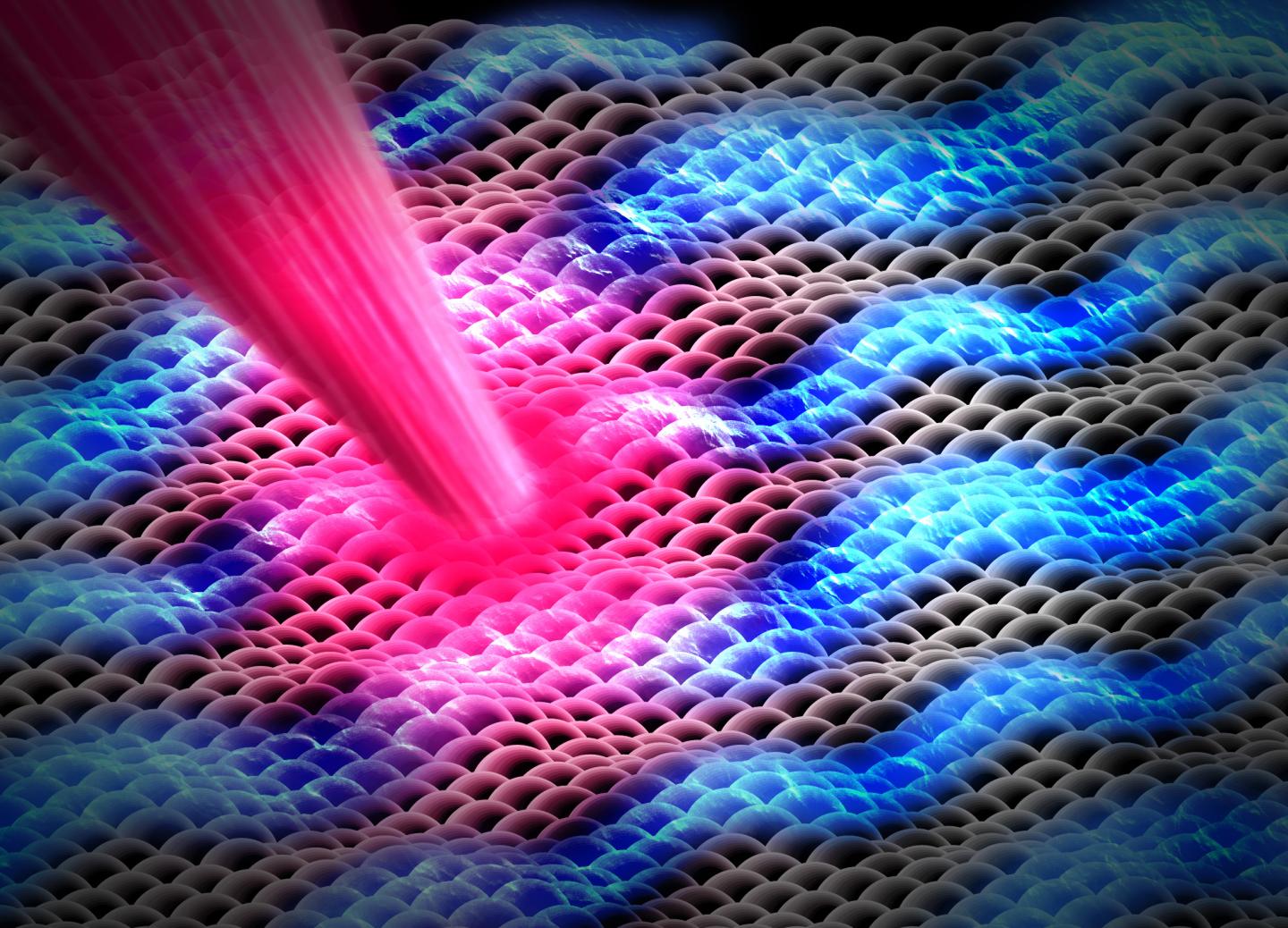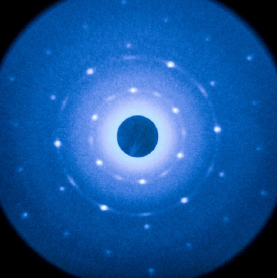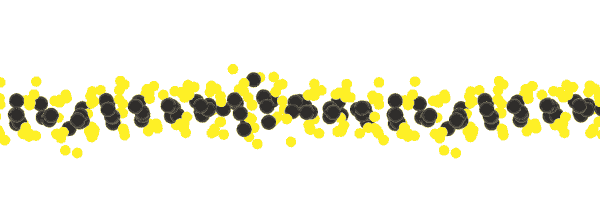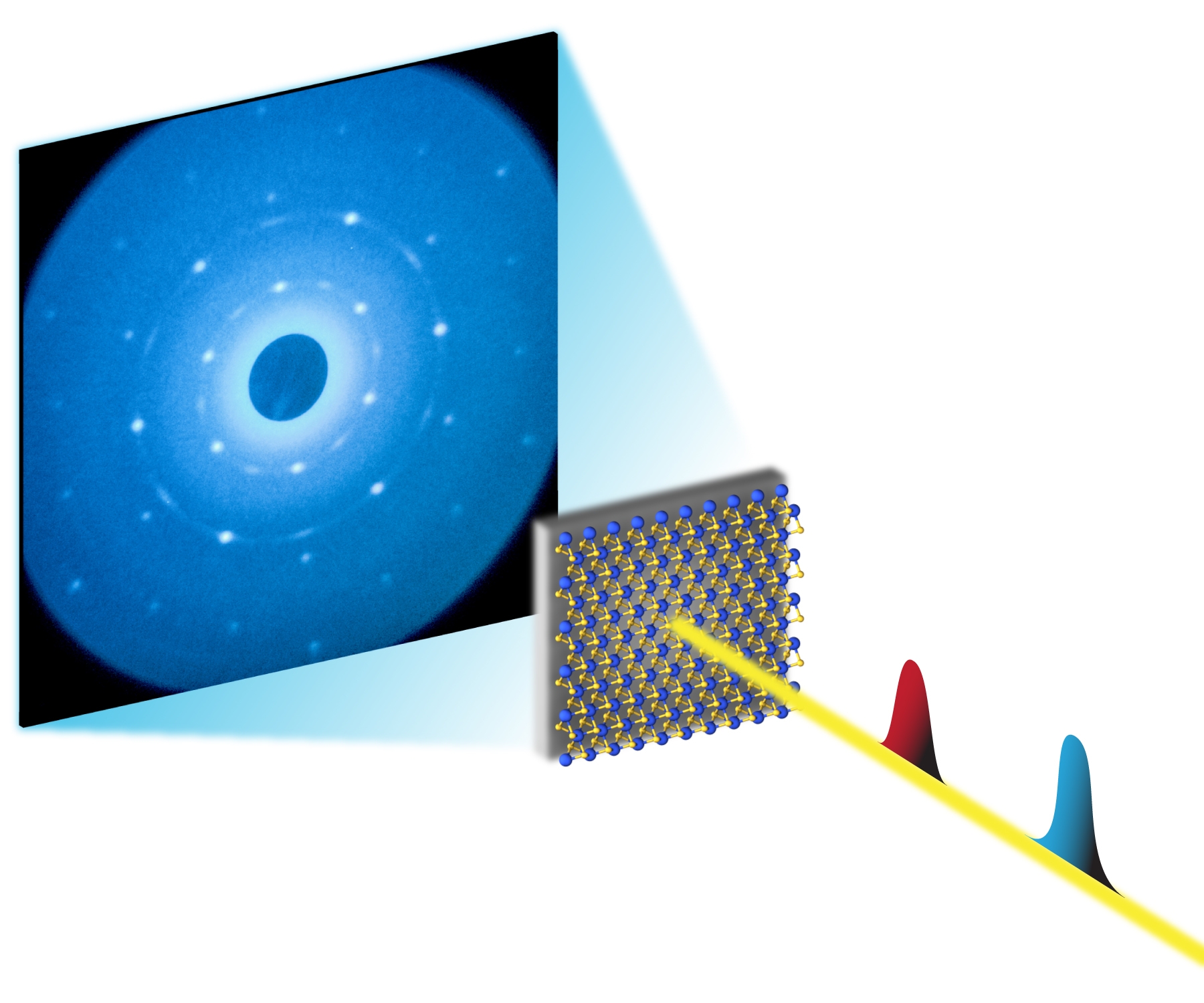Ultrafast ‘electron camera’ visualizes atomic ripples in 2-D material
September 17, 2015

Researchers have used SLAC’s “electron cameras” to take snapshots of a three-atom-thick layer of a promising material called molybdenum disulfide as it wrinkles in response to a laser pulse. Understanding these dynamic ripples could provide crucial clues for the development of next-generation solar cells, electronics, and catalysts. (credit: SLAC National Accelerator Laboratory)
A new “electron camera” can capture images of individual moving atoms as they form wrinkles on a three-atom-thick material and in trillionths of a second — one of the world’s fastest. It has been developed by scientists from the Department of Energy’s SLAC National Accelerator Laboratory and Stanford University.
This unprecedented level of detail could guide researchers in developing more efficient solar cells, fast and flexible nanoelectronics, and high-performance chemical catalysts.
The breakthrough, published Aug. 31 in Nano Letters, was made possible by SLAC’s instrument for ultrafast electron diffraction (UED), which uses energetic electrons to take snapshots of atoms and molecules.
SLAC National Accelerator Laboratory | This animation explains how researchers use high-energy electrons at SLAC to study faster-than-ever motions of atoms and molecules relevant to important materials properties and chemical processes.
Extraordinary 2-D materials
Monolayers, or 2-D materials, contain just a single layer of molecules. In this form, they can take on new and exciting properties, such as superior mechanical strength and an extraordinary ability to conduct electricity and heat. But how do these monolayers acquire their unique characteristics? Until now, researchers only had a limited view of the underlying mechanisms.

A representative electron diffraction pattern from monolayer Molybdenum disulfide (MoS2) taken with the new SLAC electron camera, showing the crystalline nature of the sample (credit: (credit: SLAC National Accelerator Laboratory)
“The functionality of 2-D materials critically depends on how their atoms move,” said SLAC and Stanford researcher Aaron Lindenberg, who led the research team.
“However, no one has ever been able to study these motions on the atomic level and in real time before. Our results are an important step toward engineering next-generation devices from single-layer materials.”
The research team looked at molybdenum disulfide, or MoS2, which is widely used as a lubricant but takes on a number of interesting behaviors when in single-layer form.
For example, the monolayer form is normally an insulator, but when stretched, it can become electrically conductive. This switching behavior could be used to function like transistors in thin, flexible electronics and to encode information in data-storage devices.
Thin films of MoS2 are also under study as possible catalysts that facilitate chemical reactions. In addition, they capture light very efficiently and could be used in future solar cells.
Because of this strong interaction with light, researchers also think they may be able to manipulate the material’s properties with light pulses.
“To engineer future devices, control them with light, and create new properties through systematic modifications, we first need to understand the structural transformations of monolayers on the atomic level,” said Stanford researcher Ehren Mannebach, the study’s lead author.
Electron camera reveals ultrafast motions
Previous analyses showed that single layers of molybdenum disulfide have a wrinkled surface. However, these studies only provided a static picture. The new study reveals for the first time how surface ripples form and evolve in response to laser light.

Visualization of laser-induced motions of atoms (black and yellow spheres) in a molybdenum disulfide monolayer: The laser pulse creates wrinkles with large amplitudes — more than 15 percent of the layer’s thickness — that develop in a trillionth of a second. (credit: K.-A. Duerloo/Stanford)
Researchers at SLAC placed their monolayer samples, which were prepared by Linyou Cao’s group at North Carolina State University, into a beam of very energetic electrons. The electrons, which come bundled in ultrashort pulses, scatter off the sample’s atoms and produce a signal on a detector that scientists use to determine where atoms are located in the monolayer. This technique is called ultrafast electron diffraction.
The team then used ultrashort laser pulses to excite motions in the material, which cause the scattering pattern to change over time.

To study ultrafast atomic motions in a single layer of molybdenum disulfide, researchers followed a pump-probe approach: They excited motions with a laser pulse (pump pulse, red) and probed the laser-induced structural changes with a subsequent electron pulse (probe pulse, blue). The electrons of the probe pulse scatter off the monolayer’s atoms (blue and yellow spheres) and form a scattering pattern on the detector — a signal the team used to determine the monolayer structure. By recording patterns at different time delays between the pump and probe pulses, the scientists were able to determine how the atomic structure of the molybdenum disulfide film changed over time. (credit: SLAC National Accelerator Laboratory)
“Combined with theoretical calculations, these data show how the light pulses generate wrinkles that have large amplitudes — more than 15 percent of the layer’s thickness — and develop extremely quickly, in about a trillionth of a second. This is the first time someone has visualized these ultrafast atomic motions,” Lindenberg said.
Once scientists better understand monolayers of different materials, they could begin putting them together and engineer mixed materials with completely new optical, mechanical, electronic and chemical properties.
The research was supported by DOE’s Office of Science, the SLAC UED/UEM program development fund, the German National Academy of Sciences, and the U.S. National Science Foundation.
Abstract of Dynamic Structural Response and Deformations of Monolayer MoS2 Visualized by Femtosecond Electron Diffraction
Two-dimensional materials are subject to intrinsic and dynamic rippling that modulates their optoelectronic and electromechanical properties. Here, we directly visualize the dynamics of these processes within monolayer transition metal dichalcogenide MoS2 using femtosecond electron scattering techniques as a real-time probe with atomic-scale resolution. We show that optical excitation induces large-amplitude in-plane displacements and ultrafast wrinkling of the monolayer on nanometer length-scales, developing on picosecond time-scales. These deformations are associated with several percent peak strains that are fully reversible over tens of millions of cycles. Direct measurements of electron–phonon coupling times and the subsequent interfacial thermal heat flow between the monolayer and substrate are also obtained. These measurements, coupled with first-principles modeling, provide a new understanding of the dynamic structural processes that underlie the functionality of two-dimensional materials and open up new opportunities for ultrafast strain engineering using all-optical methods.